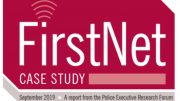Fortunately, more and more agencies are starting to embrace unmanned aerial systems technology (drones) by first responders
By Christopher Vondracek
Everywhere veteran firefighter Charles Werner travels, he hears about drones. He recently attended a Texas convention for public safety officers where some drone operators told him they practically had to sneak out of work because they are so in-demand.
Werner, who now serves as the Chief of Public Safety for DroneUp, an Unmanned Aerial System (UAS) facilitator for commercial and government uses, stated, “It’s really not about the drone, but about the data that comes from it.”
Werner rattled off a list of situations where public safety officers are better equipped to provide assistance on-scene, thanks to a drone: search-and-rescue from the California desert to the volcanoes in Hawaii, where drones can capture data about fissure movement and lava flows, to the floods in Texas or Florida-where a burst or overrun dam can be monitored.
Fortunately, more and more agencies are starting to embrace unmanned aerial systems technology (drones) by first responders. With the addition of FirstNet and its first-responder-dedicated communications network, Werner, a 40-year fire department veteran who served for ten years as fire chief of Charlottesville, Virginia, stated the moment for takeoff is now.
“Any public safety agency that doesn’t have a drone or drone program is negligent in my opinion,” said Werner. He described a taste-and-see approach many local departments take to technology that can excite and incite fears for public overreach. “Most of these agencies go in and start small and they do it just for themselves, but as soon as they start having some successful missions, others want to be involved, too.”
FirstNet’s extra layer of spectrum can provide the data capacity for drone operators to send data that it gets up in the air back down to earth. That doesn’t only mean streaming video but also sensory data, such as heat maps or C02 levels. This data can be vital for the folks on the ground. Werner has watched up-close how a city can change its perspective on drones. The City of Charlottesville, where he spent the first 37 years of his 40-year career, was the first so-called “no drone” city in the country, after the city council voted to ban UAVs. (A state law later overturned that decision.)
During the violent clashes at the Unite the Right white supremacist rally in the city in the summer of 2017, a camera strapped to a drone captured a still image of the moment an assailant’s car struck Heather Heyer. She later died of her injuries. The image, as well as other data, provided conclusive evidence for a jury to convict the driver, James Alex Fields, of first-degree murder.
Werner understands the civil liberty concerns, saying that in his conversations with the ACLU, the need for rules around the storage of data was privileged. The ACLU told him, “We don’t care about drones being able to read license plates, we don’t really care about traffic cameras, what we care about most is the data and how long you store it. If in three days of a week, you haven’t found anything and write over it, then that’s fine. But if it’s longer, you need to have the justification written down in a policy.”
When Werner looks at the new opportunities created by the FirstNet platform, with its range of spectrum and priority, and-preemption capabilities for participating first responders, he said the range of opportunities will be expansive for local agencies.
“Any kind of data is assisted,” said Werner. “You might be doing a hazmat mark-up and using Flir imagery and without a strong network, you may have an integrity issue. You need to be ready for everything. For zoom and infrared, and maybe a catch-and-release for a flotation device. In short, these operators are flying more than they thought they would and it’s putting more stress on the network. That’s why communications are key.”
Werner suggested agencies thinking about purchasing drones consider teaming up with other agencies in a community or across a region to, in his words, “spread the burden.” And if Werner’s experience in the commonwealth is any indication, the rest of the country is seeing a rapid expansion in this useful technology.
“In Virginia, two years ago there were only two public safety agencies with drones,” said Werner. “Today, that’s advanced to nearly fifty.”
Christopher Vondracek is a freelance journalist living in Washington D.C., most recently with Courthouse News.




Be the first to comment on "Public Safety and Unmanned Aerial Systems Technology"